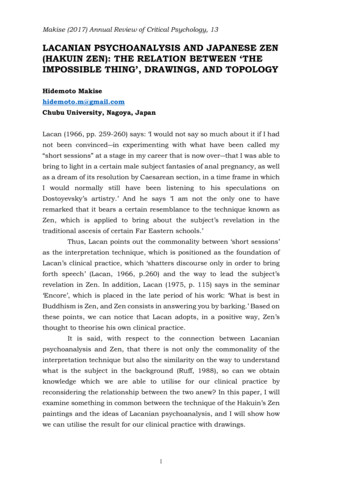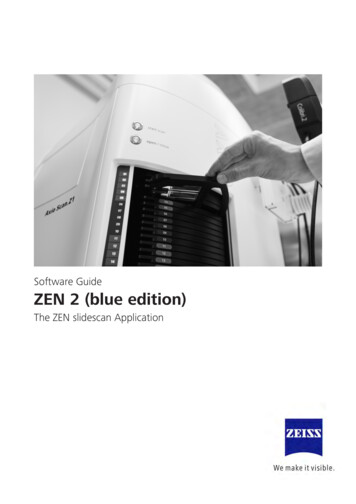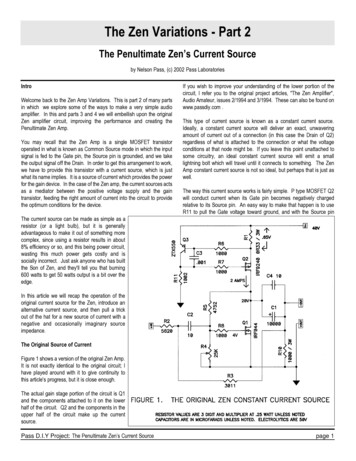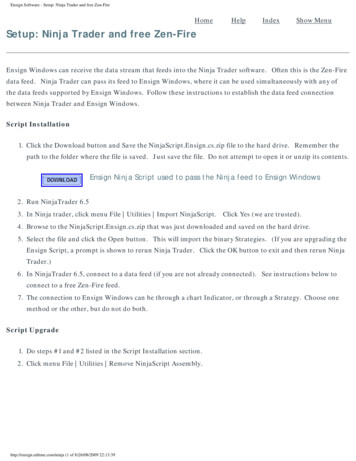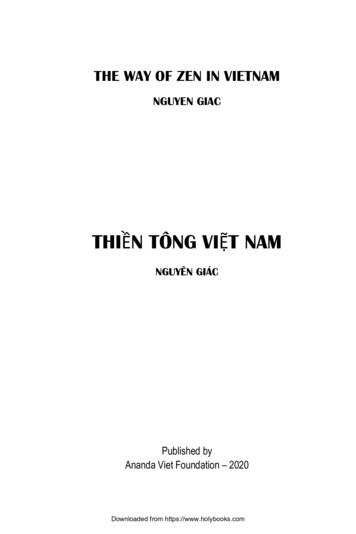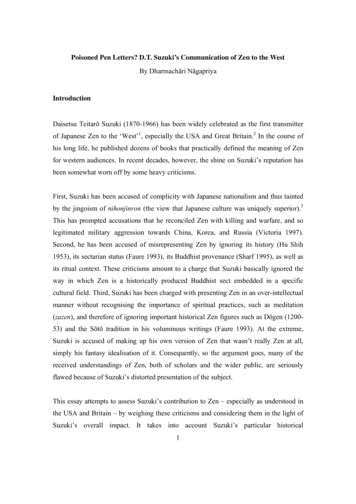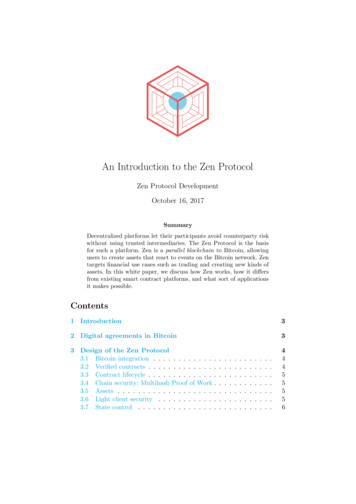
Transcription
An Introduction to the Zen ProtocolZen Protocol DevelopmentOctober 16, 2017SummaryDecentralized platforms let their participants avoid counterparty riskwithout using trusted intermediaries. The Zen Protocol is the basisfor such a platform. Zen is a parallel blockchain to Bitcoin, allowingusers to create assets that react to events on the Bitcoin network. Zentargets financial use cases such as trading and creating new kinds ofassets. In this white paper, we discuss how Zen works, how it differsfrom existing smart contract platforms, and what sort of applicationsit makes possible.Contents1 Introduction32 Digital agreements in Bitcoin33 Design of the Zen Protocol3.1 Bitcoin integration . . . . . . . . . . . . .3.2 Verified contracts . . . . . . . . . . . . . .3.3 Contract lifecycle . . . . . . . . . . . . . .3.4 Chain security: Multihash Proof of Work .3.5 Assets . . . . . . . . . . . . . . . . . . . .3.6 Light client security . . . . . . . . . . . .3.7 State control . . . . . . . . . . . . . . . .44455556
4 Other platforms4.1 Ethereum . . . . . . . . . . . . . . . . . . . . . . . . . . . . .4.2 Rootstock . . . . . . . . . . . . . . . . . . . . . . . . . . . . .4.3 Tezos . . . . . . . . . . . . . . . . . . . . . . . . . . . . . . .66785 Multihash mining5.1 Multiple hash functions . . . . . . . . . . . . . . . . . . . . .5.2 Token holder influence . . . . . . . . . . . . . . . . . . . . . .8996 Transactions106.1 Why UTXOs? . . . . . . . . . . . . . . . . . . . . . . . . . . . 107 Tokens117.1 Moving tokens: a comparison . . . . . . . . . . . . . . . . . . 127.2 Different types of token . . . . . . . . . . . . . . . . . . . . . 137.3 Using tokens . . . . . . . . . . . . . . . . . . . . . . . . . . . 138 Contracts8.1 The Active Contract Set . . . . . . . . . . . . . .8.2 Resource verification . . . . . . . . . . . . . . . .8.3 Formal verification and contract communication .8.4 How contracts work . . . . . . . . . . . . . . . .8.5 Managing assets . . . . . . . . . . . . . . . . . .8.6 Off-chain contracts . . . . . . . . . . . . . . . . .8.7 Confidential agreements and decentralized escrow.14141617171818189 Bitcoin199.1 Application: Token sale . . . . . . . . . . . . . . . . . . . . . 209.2 Application: Sidechain . . . . . . . . . . . . . . . . . . . . . . 219.3 Application: Simple cross-chain swaps . . . . . . . . . . . . . 2110 Using Zen2110.1 A call option using a Merklized Oracle . . . . . . . . . . . . . 2210.2 A token exchange . . . . . . . . . . . . . . . . . . . . . . . . . 23List of Figures123456A Bitcoin transaction . . . . . . . .A Zen transaction . . . . . . . . . .The Active Contract Set . . . . . . .Resource verification . . . . . . . . .Private agreement with decentralizedMerged consensus . . . . . . . . . . . . . . . . . . . . . . .escrow. . . .121315161920
1IntroductionBitcoin was designed to be digital money without central authority. Itsucceeded by identifying the key problem—consensus on ownership—andproviding a mechanism to reach consensus that cannot be subverted withoutusing real, costly resources. This solution, a proof of work blockchain, hassince been widely imitated.We introduce Zen, a blockchain to trade in any kind of financial assetwith the same consensus on ownership and freedom from central control thatBitcoin provides for money. These assets connect to digital agreements withpowerful, programmable abilities to process information and grant rights.Zen observes the Bitcoin network and allows for assets backed with Bitcoin.Before discussing Zen in detail, let’s look at what can be done with theBitcoin protocol itself.2Digital agreements in BitcoinBeyond consensus on transfers of money from one owner to another, Bitcoinalso permits consensus on more complicated kinds of digital agreements. Forinstance, multi-signature schemes allow bitcoins to be locked with more thanone digital key. Other digital agreements move part of the consensus off thetransaction ledger entirely, using decentralized consensus only to give eachparty the ability to defend against a broken agreement. Bitcoin’s LightningNetwork uses agreements of this kind.These sorts of digital agreement have become known as smart contracts.Smart contracts on Bitcoin have three distinctive properties:1. They relate to the flow of bitcoins themselves, i.e. money, rather thanother assets.2. They consume network resources otherwise used for the direct transferof money.3. They are only necessary for applications which have to be free of centralcontrol.Bitcoin supports smart contracts just as well as is needed to improveBitcoin’s ability to be decentralized digital money. To this end, Bitcoin’sscripting language is intentionally restrictive, preventing contracts fromconsuming excessive resources, and requiring them to be extremely efficient. Ifpossible, Bitcoin smart contracts pay their own way by replacing transactionswhich would otherwise have to be recorded on the blockchain.For assets other than Bitcoin, and for contracts which require more thana minimal amount of computation to validate, Bitcoin does not provide theright solution for reaching consensus. These uses compete with Bitcoin’sPage 3 of 24zenprotocol.comIntroduction
monetary function—secure, reliable digital money without central control.This conflict is not particular to Bitcoin. Any blockchain which attemptsboth to create money and to provide smart contracts must limitone or the other.3Design of the Zen ProtocolThe Zen blockchain is designed to support real financial products, withpowerful automation and freedom from central control. These uses motivatemany decisions about the Zen Protocol’s architecture. This section gives ahigh-level overview of that architecture.3.1Bitcoin integrationZen has a scarce native token for contract activation, but this token is notintended as monetary competition. Rather, Zen supports tight integration with the Bitcoin blockchain, allowing for Bitcoin-backed assets that canbe used as currency on the Zen Protocol. The scarce native token means thatthere’s no need for an “official” Bitcoin-backed asset1 : multiple, competingservices put Bitcoin-value onto the Zen blockchain. At the same time, thenative token lowers the cost of using Zen by subsidizing the miners whosecure the chain. Every Zen full node keeps track of Bitcoin consensus, givingcontracts the ability to use the state of the Bitcoin blockchain when decidingwhat actions to take. The Zen Protocol attempts to be forward-compatiblewith updates to Bitcoin, such as drivechains, that offer a decentralized wayto move Bitcoins between different blockchains.This solves the problem of smart contracts competing for the resourcesused to secure money transfer.3.2Verified contractsContracts come with proofs about how long they take to run—which meansthey can be compiled and run much faster—and can come with proofs aboutwhat they do—which means that other contracts can understand themand treat their assets accordingly. All these proofs are written in the samelanguage as the contracts themselves. Section 8.2 explains how these proofswork.Zen contracts never cost the user resources unless they execute successfully—there are no “out of gas” errors.1See Rootstock, discussed below, for a blockchain that does have an “official” asset.Page 4 of 24zenprotocol.comDesign of the Zen Protocol
3.3Contract lifecycleIn Bitcoin, the full code of a “contract” is recorded in the blockchain eachtime it is used. In Ethereum, contracts are created once, and then go on tolive in the blockchain indefinitely. Zen contracts are pay-per-block : they payminers for every single block in which they are active. This is a miner-friendlyand node-friendly solution to persistent contracts: only the contracts thatcan actually affect the blockchain are cached in memory, and miners get paidfor caching them.3.4Chain security: Multihash Proof of WorkZen uses proof of work to secure the blockchain’s transaction history. Proof ofwork demands that miners invest real, unforgeable resources. The commonlyproposed alternative, proof of stake, has not been demonstrated to combinesecurity, open access and incentive compatibility. In particular, the “stake”of “proof of stake” is the same asset with which the stakers are compensated.This entrenches existing owners of the asset at the expense of future users.Proof of stake also couples the security of the blockchain to the value of aparticular token in the blockchain: if the token changes in value, the cost ofrewriting the blockchain also changes. This is not the case for proof of work,where the cost of rewriting the blockchain is determined by the physicalresources that were used to secure it.Miner centralization describes the phenomenon of mining power becomingconcentrated in the hands of a few individuals or companies. This is a realconcern for a decentralized platform, and has even become a concern forBitcoin. Zen reduces the influence of a single powerful miner by introducingmultihash mining, described in section 5 and in Perlow and Cook (2017).3.5AssetsThe idea of owning an asset has the same basic meaning in Zen as in Bitcoin:it means being able to “unlock” that asset with a digital signature. Zen usesstandard public-key authentication for user-owned assets.Zen supports multiple assets types at the protocol level. That means thatall contracts can understand and use all assets, and that assets can be heldand moved with simple, efficient public-key authentication. It lets assets beused in a Zen-based Lightning Network and makes it easy to swap them withassets held on other blockchains. Contracts make their own assets and definetheir uses.3.6Light client securityIn a decentralized smart contract platform like Zen, it’s unlikely that userson less powerful devices like mobile phones will download and fully validatePage 5 of 24zenprotocol.comDesign of the Zen Protocol
the entire blockchain. This makes it very important that these users still beable to obtain a good level of security, without trusting a centralized sourceof information. Bitcoin’s solution, Simplified Payment Verification or SPV,uses proof of work “on top of” a transaction. Zen does the same, includingadditional commitments—information that light clients can use to proveadditional properties, such as whether a contract is active or not. Zen usesdata structures like the efficient sparse merkle tree that are fast to updateand that make proofs fast to generate.3.7State controlAll blockchains have state, and give transactions access to some of that state.One simple example is that each transaction “knows” whether the value ittransfers actually exists or not! The Zen Protocol controls where state canlive: with limited exceptions, the only mechanism is to put data in transactionoutputs. This is similar to Bitcoin, and distinct from protocols like Ethereumand Tezos, which allow contracts to store data in a global store. Contractsin Zen are immutable. They can store their state in transaction outputs, buttheir source code never changes.This design makes it easier to reason about smart contracts. Unlikeprotocols in which rights are administered via data areas with so-called“private” access rights, the Zen Protocol makes it clear that rights should begranted either by cryptographic authentication, or by possession of tokens.4Other platformsApart from Bitcoin, which restricts smart contracts to those which movebitcoins and don’t compete with Bitcoin’s own monetary function, otherblockchains have offered smart contracts2 . We look at a few of them to seehow they compare with the Zen Protocol’s solution.4.1EthereumEthereum tries to provide both a currency, Ether, and a platform for decentralized applications, or dApps. It implements these applications in a single“world computer”. Assets are implemented in this world computer as a kindof application, at a higher level of abstraction than Ether itself. This meansthat in Ethereum, all transactions must be paid for in Ether. Contrast thiswith Zen, where only contract creation requires the native token—a normaltransaction fee can be paid with any asset. Using the internal currency asthe unit of account creates the conflict we mentioned above: the dApps make2Non-blockchain solutions like Open Transactions are also available. We limit ourselvesto discussing platforms which purport to be free of central authority.Page 6 of 24zenprotocol.comOther platforms
moving Ether more expensive, and the monetary function makes the dAppsmore expensive.Without first class assets, doing anything with an Ethereum token meansrunning the dApp that created it—even sending it to another user. ThedApps themselves can’t understand new asset types without a trusted humanin the loop to verify they’re “real” tokens.Ethereum intends to move to the so-called “proof of stake” system fordetermining consensus, retiring proof of work. While proposed as a potentialefficiency measure, it is not clear how this could prevent contention forresources between the monetary function and smart contract capability.Ethereum’s contracts are notoriously hard to verify as correct. This is nota fault particular to Ethereum—“formal verification” is often difficult—butEthereum was not designed to make verification easy. This extends to proofsabout how long contracts take to execute. When these proofs exist3 , they’reuseful to measure how much gas is necessary, but don’t fix the fundamentalproblem that the gas system creates: slow, interpreted contracts that canfail in the middle of execution, while costing the user money.The gas system creates another problem, which formal verification cannotsolve: if users give conflicting instructions to a contract, then only one canwin the race, but all the users must pay for making the transaction. What’sworse, miners are incentivized to re-order transactions so that the one whichpays the most gas wins.4 This particularly affects applications like auctions,markets and capped token sales.4.2RootstockQuite simply, Rootstock is intended to be Ethereum with bitcoins insteadof Ether. This involves using a sidechain—a blockchain which connects toBitcoin, enabling users to move bitcoins on and off the sidechain. Rootstock’ssmart contract logic and internal architecture are almost identical to thoseof Ethereum, with the same shortcomings.As a sidechain, Rootstock goes some way towards separating monetaryfunctionality from smart contract capability, but we consider it unlikely thatit will solve the problem, for two reasons. Firstly, by adopting Ethereum’sarchitecture, Rootstock demands that the user pay for every single transactionwith Rootstock-bitcoins, just as every Ethereum transaction must be paid forwith Ether. This means that the more smart contracts are used, the greaterthe impact on the monetary supply, the ease of sending money betweenpeople, and so on. Secondly, the cost of securing Rootstock’s blockchain ispaid entirely in transaction fees, meaning that short-term fluctuations in the3Bhargavan et al. (2016) demonstrate gas-cost proofs by translating Ethereum contractsto F*.4This scenario—everyone pays to bid, only one person wins—is known as an all-payauction.Page 7 of 24zenprotocol.comOther platforms
overall demand for smart contracts have an immediate effect on the securityof the platform.Rootstock has stated its intention to move to a decentralized sidechainmodel when the Bitcoin protocol supports a suitable mechanism, such asdrivechains. However, in its current form, Rootstock has a central authority.Rootstock’s mechanism for moving bitcoins between chains is a single, trusted“federation”. In the federation model, a group of companies acts as depositories,holding the bitcoins of everyone using the sidechain, and releasing themaccording to the rules of the Rootstock protocol. As a key purpose of ablockchain is to remove the need for trust in a single authority, this makesthe blockchain itself unnecessary!4.3TezosTezos is a clean-sheet design for a blockchain. Intended as “the last cryptocurrency”, it aims to supplant both Bitcoin and Ethereum by providingmoney and performant smart contracts, with a decentralized mechanism forupgrading the blockchain itself5 .As a single-asset blockchain which competes for the monetary function,Tezos suffers from a conflict with smart-contract functionality. Unlike Zen,it will use proof of stake. However, it shares with Zen the goal of making iteasy to prove things about contracts.Tezos uses a custom stack-based language called Michelson. However, theproofs are not written in Michelson—they will be written in existing theoremproving systems like Isabelle or Coq. Apart from requiring programmers tolearn more than one new language, this means that the Tezos protocol itselfwill not be able to use these proofs initially6 .Tezos does not even attempt to prove how long contracts take to execute.It simply takes the brute force approach of putting a global limit on executiontime. This means Tezos contracts must be interpreted, not compiled, andguarantees either that quick contracts will be too expensive or that slowcontracts will be too cheap.5Multihash miningFor a full overview of multihash mining, see the paper.Back to Zen. This section discusses a new way to secure the blockchainwith proof of work: Multihash mining.Proof of work ties blockchain integrity to real work. As occurs in almostany sort of work requiring capital investment, miners benefit from economies5Users submit patches written in OCaml, which coin-holders then vote on.It might still be possible to write a “Coq-parsing patch” in OCaml and submit it as aprotocol upgrade. We consider this. inelegant.6Page 8 of 24zenprotocol.comMultihash mining
of scale, which can lead to fewer independent miners. This miner centralizationintroduces several risks, one of which is increased conflict between minersand users.To mine efficiently, each individual miner must specialize, buying equipment which is particularly good at mining under some particular hash functionor category of hash functions. For instance, Bitcoin miners use ASIC-basedhardware which can only mine under the SHA-256 2 algorithm. Litecoinminers use ASIC hardware which can only mine under the scrypt function.Meanwhile, some hash functions do not yet have specialized hardware—minersnormally use GPUs or CPUs with these functions.Multihash mining takes advantage of the natural economies of scaleimplicit in proof of work, using them to reduce the risk of miner-user conflict.5.1Multiple hash functionsEach block in Zen has a proof of work attached. The Zen Protocol accepts anyof several different kinds of proof of work, each corresponding to a differenthash function. Each hash function has its own difficulty: nodes verify blocksby checking the proof of work against the difficulty of the hash function used.Without any additional changes to the basic proof of work algorithm, thisleads to the difficulties becoming unbalanced over time. Unpredictable events,like different rates of improvement in hardware, or changing profitabilityon other blockchains, make it relatively too easy or too hard to mine ona particular hash function. The Zen Protocol resolves this by targeting ahash function ratio. The number of blocks mined under each hash functionis counted over a two week period, and the difficulty of each hash function isadjusted to create more or fewer blocks over the next period.5.2Token holder influenceThe hash function ratio is not fixed: owners of the Zen native token canchange it over time. Every two weeks, each owner of the Zen native token canvote on which mix of hash functions will be used. If the mix shifts towardsa particular function, that function’s difficulty is reduced, making miningeasier and increasing the reward for its miners. If the mix shifts away, then adifficulty increase reduces the reward for the miners using that function.Because miners specialize in some algorithm or algorithms, this vote hasa real effect on their profitability. However, miners are not affected as quicklyas they would be in the case of a hard-fork to change the proof of work, andthe effects of the change can be reversed with the next vote. We expect thatthis “iterated game” will encourage miners and token holders to cooperate.Page 9 of 24zenprotocol.comMultihash mining
6TransactionsIn the Zen Protocol, all value is stored in “unspent transaction outputs”, orUTXOs for short. UTXOs have two parts:1. the value they store,2. the conditions for unlocking that value.The value in a UTXO is simply a quantity of some asset/token. (Zen hasmany different kinds of token.) A condition for spending a UTXO is called alock. There are two classes of lock:Simple locks correspond to very common use-cases. One example is thePKLock, which does the same thing as pay-to-pubkey-hash (P2PKH)in Bitcoin. For example, to spend a UTXO with the lock PKLockBCFF.3A12, a transaction must contain a signature for the publickey with hash BCFF.3A12.Contract locks can only be unlocked by a contract. A UTXO with thelock ContractLock 65B9.47C4 can only be spent by the contractwith identifier 65B9.47C4.This makes transactions similar to those in Bitcoin—they unlock inputs,and lock the value to new “outputs”. Signatures, information for contractsetc. all go into a special “witness” field. There is no equivalent to Bitcoin’sscript language—contracts handle all the complex logic.Witnesses don’t affect the hash of a transaction. This means that transactions in the Zen Protocol are protected from malleability attacks—the samebenefit which Bitcoin gets from its SegWit upgrade.Users don’t see things like PKLock BCFF.3A12. For convenience, addresses are encoded with error protection and a short identifier—Zen usesBitcoin’s new Bech32 format (Wuille, 2016).6.1Why UTXOs?The two common paradigms for blockchains are UTXO-oriented and accountoriented. In the UTXO-oriented paradigm, assets are stored on outputs,which are destroyed as soon as they are spent. Think of this as taking somecoins, melting them together, and casting new coins: the amount of metalin the new coins has to be the same as in the old, but the individual coinsmay look different, be marked with different owners, and be of different sizes.We refer to the UTXO-oriented paradigm as coin-oriented to emphasize theimportance of the coins themselves.In the account-oriented paradigm, assets live in a particular account, and“sending an asset” means removing an asset from one account and puttingit inside another account. The account-oriented paradigm is slightly moreintuitive, but the UTXO/coin-oriented model has several advantages:Page 10 of 24zenprotocol.comTransactions
Non-blocking transactionsNaive account-oriented protocols suffer from a replay attack vulnerability,by which valid transactions can be used more than once. For instance, aftertaking payment from someone, an attacker can reuse the same transactionto drain the buyer’s account.To prevent these vulnerabilities, account-oriented protocols require thateach transaction from an account include a counter that increases by oneevery time the account is used. This forces transactions to occur in theblockchain in the same order in which they were created, with no gaps.Unfortunately, this leads to poor performance under load: each transactionblocks any further transactions from that account until it is either minedor dropped from miners’ mempools. Account-oriented protocols encouragethe user to keep only one account: any user who does so can be completelyblocked from using the blockchain until the network load event is over.Coin-oriented protocols are not susceptible to this vulnerability: attempting to reuse a transaction means attempting to spend the same coins, whichis impossible. With no transaction counter, coin-oriented protocols usuallyperform better under load.Parallel validationIn Bitcoin, any transaction can be validated with very limited data: knowingthat its inputs are unspent, together with the current block height andtimestamp, is enough. The effects of a transaction are simply that the inputsare consumed and the outputs are created. This makes it possible to validatemost transactions independently of each other. Zen transactions can requirea little more information, and have more effects, but most transactionsdo not affect each other’s validity, and it’s fast to check which ones do.Account-oriented systems usually need strictly linear validation, as the orderof transactions can have arbitrary, hard to check effects on validity.State managementCoin-oriented protocols make it natural to use contracts where all or mostof the state—data which changes over time—is stored attached to the coinsthemselves. This makes it very clear how different contracts can affect eachothers’ state, and gives them full control over how they manage their ownstate. In practice, many digital agreements don’t require any state at all—these agreements can simply not create any state-carrying coins.7TokensUnlike Bitcoin, which has only one kind of token, and protocols like Ethereum,which use custom contracts to implement some of the functionality of tokens,Page 11 of 24zenprotocol.comTokens
the Zen Protocol’s tokens are first class citizens. That means that everysort of token in Zen has a similar status to the Zen native token. Tokens arestored in transaction outputs, just as in Bitcoin, and can be unlocked withthe right permissions, then locked again in new outputs.7.1Moving tokens: a comparisonIn Bitcoin, the value of a transaction’s output represents a certain numberof bitcoins locked in that output. Bitcoins are spent by unlocking outputs,then locking its bitcoins inside new outputs. For instance, this transactiontakes an output with five bitcoins, another output with two bitcoins, unlocksthem both, and locks them in two new outputs:BTC TRANSACTIONINPUT 0 5 BTCINPUT 1 2 BTCOUTPUT 0 4 BTC4 B TCU T XOOUTPUT 1 3 BTC3 B TCU T XOFigure 1: Bitcoin transactions unlock inputs, freeing the bitcoins inside—thenimmediately lock those bitcoins inside new outputs.The two new unspent transaction outputs (UTXOs) are then availableto be spent.In Zen, transaction outputs can lock tokens of any type. This transactionunlocks a UTXO carrying two of token X, another UTXO carrying threeof token Y, and a third carrying five of token X (the same type as the firstUTXO), then locks them to some new outputs:Page 12 of 24zenprotocol.comTokens
ZEN TRANSACTIONINPUT 0 2 TOKEN XINPUT 1 3 TOKEN YINPUT 2 5 TOKEN XOUTPUT 0 7 TOKEN X7 TO K E N XU T XOOUTPUT 1 2 TOKEN Y2 TO K E N YU T XOOUTPUT 2 1 TOKEN Y1 TO K E N YU T XOFigure 2: Zen transactions can unlock any kind of asset. They immediatelylock those tokens to new owners, inside new transactions outputs.Just as for Bitcoin, the new UTXOs can be spent according to their newconditions, or locks.7.2Different types of tokenEach contract can create 2256 kinds of token. There are almost 2256 possiblecontract IDs, so in total, there are almost 2512 possible kinds of token.Zen also has a single asset which is not issued by a contract. This is thenative, mined ZEN token. We discuss the need for this token in section 8.1.1.7.3Using tokensFirst class tokens provide a convention for representing financial rights. Bothcontracts and users can immediately see which assets they hold—withoutpassing messages to other contracts, parsing contract code, or using a trustedsource of information about assets. This makes it easy to create powerfuldigital agreements: for instance, a contract can accept any kind of asset ascollateral, then issue a token acting as a option on that asset, without knowinganything about the asset itself. Users who own this contract’s options cansee them in their wallets without any upgrades, add-ons, etc.Page 13 of 24zenprotocol.comTokens
Zen’s token support also makes it easy to sell and transfer rights. Considerthe example of an interest rate swap. This is a popular financial productin which two parties agree to pay each other interest payments on somelump of capital. One party agrees to pay at a fixed interest rate, whilethe other pays at a floating (market) rate of interest. In Zen, this digitalagreement would use a contract that issues two different kinds of token, onerepresenting the fixed rate, the other the floating rate. The contract alsoholds a reasonable amount of collateral from each party, in order to coverthe expected payments.Suppose that the party which pays a fixed rate wants to close his position.Once he finds someone willing to buy him out, it takes only a single transactionto exchange the payment for the token which grants the right to the “fixedleg”. This transaction happens without interacting with the interest rateswap contract.8ContractsContracts and users have similar abilities in the Zen Protocol. Both interactwith the blockchain by creating transactions. Contracts and users can evenco-operate to create a single transaction—the basis of “level 2” protocols.But whereas users are pseudonymous, and use public key cryptographic tocontrol their assets, each contract has a unique identifier, and automaticallyhas control over assets locked to that identifier.8.1The Active Contract SetContracts live in the active contract set. Only contracts in this set can createtransactions and interact with the blockchain (Figure 3). Contracts enterthe ACS when a user pays a contract sacrifice in the Zen native token, partof which goes to the miner who activates the contract, with the rest goingto all the miners over the contract’s lifetime. Contracts can be extended byadditional contract sacrifices. When their sacrifices run out, they leave theACS, becoming inactive until someone reactivates them by providing sourcecode and a new sacrifice.8.
An Introduction to the Zen Protocol Zen Protocol Development October 16, 2017 Summary Decentralized platforms let their participants avoid counterparty risk without using trusted intermediaries. The Zen Protocol is the basis for such a platform. Z
